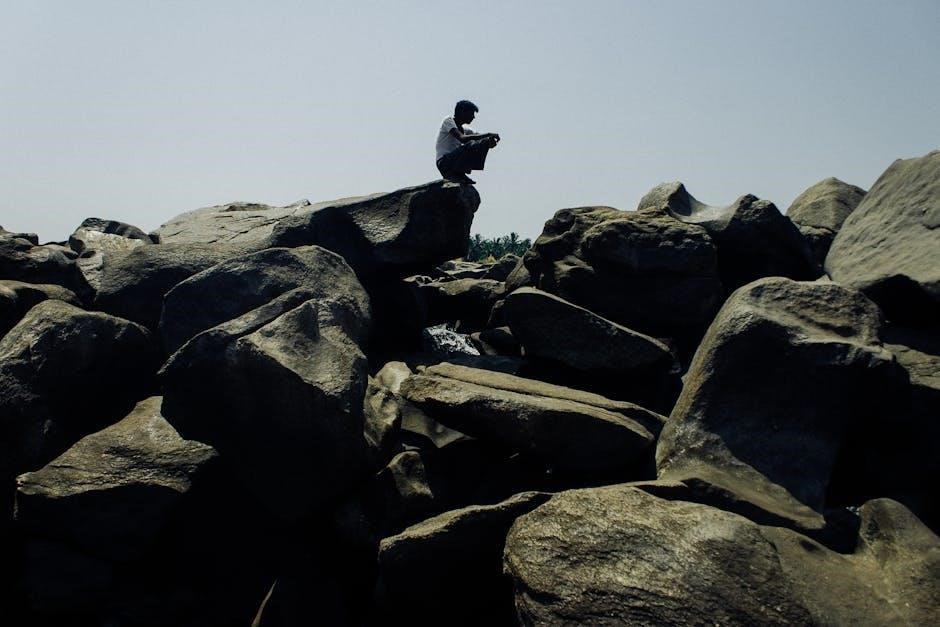Travelers often compare Rough Guides and Lonely Planet, two popular guidebooks with distinct styles; Rough Guides focus on detailed listings, while Lonely Planet emphasizes storytelling and cultural insights, catering to different traveler needs.

History and Philosophy of Travel Guides
Born in the 1970s, Lonely Planet emerged from a backpacking revolution, while Rough Guides debuted in the 1980s, offering detailed, practical insights. Both aim to inspire and inform travelers globally.
2.1. Rough Guide: Origins and Evolution
Rough Guides was founded in 1982 by Mark Ellingham, emerging as a competitor to Lonely Planet. The first guide focused on Greece, offering detailed practical information. Over time, the series expanded globally, blending cultural insights with listings. Known for its comprehensive approach, Rough Guides became popular among independent travelers seeking in-depth knowledge. The guides emphasize authenticity, catering to those who want immersive experiences. Today, Rough Guides remains a trusted source, adapting to digital formats while maintaining its core philosophy of detailed, reliable travel information.
2.2. Lonely Planet: Founding and Development
Lonely Planet was founded in 1973 by Tony and Maureen Wheeler, inspired by their overland journey from London to Australia. Their first guide, Across Asia on the Cheap, became a cult classic, catering to budget-conscious travelers. The series quickly gained popularity for its practical advice and cultural insights, becoming a favorite among independent and backpacker communities. By the 1980s, Lonely Planet had expanded its coverage globally, offering guides for destinations worldwide. Known for its trustworthy recommendations, the brand became synonymous with adventurous travel. In the 2000s, Lonely Planet embraced digital tools, launching e-books and mobile apps to adapt to modern travelers’ needs. While some users feel the quality has declined in recent years, Lonely Planet remains a trusted resource for millions, blending storytelling with essential travel information.
Target Audience and Traveler Profiles
Rough Guides and Lonely Planet cater to diverse traveler profiles, with Rough Guides appealing to independent and budget travelers, while Lonely Planet attracts a broader audience, including families and luxury seekers.
3.1. Rough Guide: Focus on Independent and Budget Travelers
Rough Guides primarily cater to independent and budget travelers, offering detailed listings and practical information. They provide comprehensive coverage of accommodations, dining, and transportation, emphasizing affordability and authenticity. With a focus on off-the-beaten-path destinations, Rough Guides appeal to travelers seeking unique experiences without breaking the bank. Their honest reviews and tips help budget-conscious explorers make informed decisions. The guides are particularly popular among backpackers and those who prefer to plan their trips meticulously. By prioritizing value and local insights, Rough Guides have established themselves as a trusted resource for travelers who value independence and cultural immersion. Their approach resonates with those who seek a more authentic and cost-effective way to explore the world.
3.2. Lonely Planet: Catering to a Broad Range of Travelers
Lonely Planet is renowned for its ability to cater to a wide range of travelers, from budget-conscious explorers to luxury seekers. Unlike Rough Guides, Lonely Planet organizes its content by budget, making it easier for travelers with varying preferences to find suitable options. The guide is particularly praised for its storytelling approach, which immerses readers in the culture and history of destinations. Lonely Planet also includes sections on dangers and annoyances, offering practical advice that appeals to cautious travelers. While some critics argue these sections can be overly alarmist, they provide a level of preparedness that many travelers appreciate. Lonely Planet’s broad appeal lies in its balanced approach, offering something for everyone while maintaining a focus on independent travel. Its global perspective and user-friendly organization make it a favorite among travelers of all styles and budgets.

Content Style and Structure
Rough Guides emphasize detailed listings and practical information, appealing to independent travelers. Lonely Planet, meanwhile, blends storytelling with cultural insights, offering a more immersive travel experience. Both cater to diverse travel styles.
4.1. Rough Guide: Detailed Listings and Practical Information
Rough Guides are renowned for their comprehensive and detailed listings, making them a favorite among independent and budget travelers. They provide in-depth information on accommodations, restaurants, and attractions, often highlighting lesser-known options. The guides are structured to help travelers navigate destinations efficiently, with a focus on practicality. For instance, they include detailed maps and transportation tips, which are invaluable for those exploring unfamiliar areas. Rough Guides also emphasize cost-effectiveness, offering budget-friendly recommendations without compromising on quality. Their no-frills approach ensures that travelers can make the most of their trips without unnecessary expenses. This focus on detailed, actionable information has made Rough Guides a trusted companion for travelers seeking authentic experiences. Their listings are thorough, ensuring that readers have all the necessary details to plan their itineraries confidently.

4.2. Lonely Planet: Storytelling and Cultural Insights
Lonely Planet guides are celebrated for their engaging storytelling and rich cultural insights, offering travelers a deeper connection to the destinations they explore. Unlike Rough Guides, Lonely Planet focuses on weaving narratives that highlight the unique character of places, making the content more immersive. Their guides often include anecdotes, historical context, and local perspectives, which help travelers appreciate the cultural significance of landmarks and experiences. This approach makes Lonely Planet a favorite among travelers seeking more than just practical information—it inspires curiosity and encourages exploration. The guides also emphasize visual storytelling through high-quality photography, enhancing the reader’s ability to visualize destinations. While they provide detailed listings, the emphasis on storytelling sets Lonely Planet apart, making it a go-to choice for travelers who value cultural depth and inspiration. This blend of information and narrative creates a memorable reading experience.

User Preferences and Reviews
Travelers often express strong preferences, with some favoring Lonely Planet for its organized structure and cultural insights, while others prefer Rough Guides for their detailed, practical approach and unbiased listings.
5.1. Why Travelers Choose Rough Guide
Many travelers prefer Rough Guides for their detailed and practical approach to travel planning. The series is known for its comprehensive listings, which cover a wide range of destinations, from modern cities to off-the-beaten-path locations. Rough Guides are often praised for their focus on independent and budget travelers, offering tips on affordable accommodations, dining, and activities. Users appreciate the guide’s unbiased and in-depth information, which helps them make informed decisions. Additionally, Rough Guides are seen as more grounded and less alarmist compared to Lonely Planet, avoiding overly cautious advice. This makes them a favorite among travelers who value authenticity and want to immerse themselves in local cultures without being discouraged by potential challenges. The guides’ emphasis on detailed knowledge and practical insights has earned them a loyal following among those seeking a no-frills, reliable travel companion.
5.2. Why Travelers Choose Lonely Planet
Lonely Planet is a favorite among travelers for its engaging storytelling and cultural insights, making destinations come alive. The guides are well-organized, with listings often sorted by budget, appealing to a broad range of travelers, including families and luxury seekers. Lonely Planet’s user-friendly approach and visually appealing layouts make trip planning easier, especially for visual learners. Many appreciate the guide’s ability to balance practical information with inspiring narratives, helping travelers discover both iconic and lesser-known spots. Additionally, Lonely Planet’s digital tools and active community engagement enhance the travel experience. While some critics find the guides overly cautious, others value their thorough coverage and trusted recommendations. Overall, Lonely Planet’s blend of organization, cultural depth, and accessibility makes it a go-to choice for many exploring the world.

Regional Focus and Specialization
Rough Guides excel in European and North American destinations, offering detailed insights, while Lonely Planet provides global coverage, highlighting iconic and diverse locations for varied traveler preferences.
6.1. Rough Guide: Strength in European and North American Destinations
Rough Guides are renowned for their comprehensive coverage of European and North American destinations, offering detailed insights into local culture, history, and practical information. They provide in-depth listings for accommodations, dining, and attractions, particularly catering to independent and budget travelers. Their focus on these regions ensures that readers can explore hidden gems and off-the-beaten-path locations, making them a favorite among travelers seeking authentic experiences. The guides are also praised for their balanced approach, blending historical context with modern attractions, ensuring a well-rounded travel experience. This specialization has established Rough Guides as a trusted resource for those venturing through Europe and North America, delivering reliable and detailed information that enhances any journey.
6.2. Lonely Planet: Global Coverage and Iconic Destinations
Lonely Planet is celebrated for its extensive global coverage, offering in-depth guides for iconic destinations worldwide. With a strong focus on cultural insights and practical information, they cater to a broad range of travelers. Their guides are particularly admired for their detailed sections on must-visit attractions, hidden gems, and local experiences. Lonely Planet’s global approach ensures that readers can explore destinations from bustling cities to remote landscapes with confidence. Some users note that their sections on dangers and annoyances can be overly cautious, but this thoroughness is often appreciated by first-time travelers. Overall, Lonely Planet’s ability to balance detailed information with engaging storytelling makes it a preferred choice for those seeking a comprehensive understanding of iconic destinations and global cultures. Their guides are trusted companions for travelers aiming to immerse themselves in the world’s most captivating places.
Strengths and Weaknesses
Rough Guides excel in detailed listings for independent travelers but lack visual appeal. Lonely Planet offers organized, culturally rich content yet sometimes seems overly cautious in its approach to travel advice.

7.1. Rough Guide: In-Depth Listings but Less Visual Appeal
Rough Guides are renowned for their meticulous attention to detail, providing comprehensive listings of accommodations, dining, and attractions. This focus makes them a favorite among independent travelers seeking practical, budget-friendly options. However, their minimalist design and lack of high-quality visuals can be off-putting to some, particularly visual learners. Despite this, their in-depth information compensates for the absence of visual flair, offering travelers a reliable resource for navigating diverse destinations. This balance of functionality and simplicity has solidified Rough Guides as a trusted choice for those prioritizing detailed content over aesthetic appeal.
7.2. Lonely Planet: Organized but Sometimes Overly Cautious
Lonely Planet is celebrated for its organized structure, making it easy for travelers to navigate and plan their journeys. Its clear categorization of listings by budget and type is particularly praised. However, some users find the guide overly cautious, with extensive sections on dangers and annoyances that may alarm rather than inform. This approach can sometimes overshadow the excitement of exploring new destinations. Despite this, Lonely Planet remains a favorite for its storytelling style and cultural insights, which enrich travelers’ experiences. While its cautious tone may not suit all, its organizational strengths and depth of information ensure it remains a trusted companion for many globetrotters.
Digital Presence and Modern Adaptations
Rough Guides and Lonely Planet have embraced digital transformation, offering online resources, mobile apps, and interactive tools to enhance traveler experiences, adapting to modern demands while retaining their core strengths.
8.1. Rough Guide: Online Resources and Apps
Rough Guides has expanded its digital offerings to cater to modern travelers. Their website features detailed destination guides, travel tips, and interactive maps, making trip planning more accessible. The Rough Guide app provides offline access to content, allowing users to navigate without internet connectivity. Additionally, the app includes customizable itineraries and bookmarking features, enhancing user convenience; Rough Guides also integrates social media platforms to engage with travelers, sharing updates and user-generated content. These digital tools complement their printed guidebooks, ensuring that travelers have comprehensive resources both online and offline. By adapting to digital trends, Rough Guides remains relevant in the evolving travel landscape, offering practical and inspiring content for diverse traveler needs.
8.2. Lonely Planet: Digital Tools and Community Engagement
Lonely Planet has embraced digital innovation to enhance traveler experiences. Their website and mobile app offer comprehensive destination guides, interactive maps, and offline access, making trip planning seamless. The app features personalized itineraries, booking options, and real-time updates, catering to diverse traveler needs. Lonely Planet also fosters a strong community through social media and forums, where travelers share experiences and tips. User-generated content and engaging stories create a vibrant platform for inspiration and connection. By integrating digital tools with community engagement, Lonely Planet continues to evolve as a trusted resource for modern travelers, blending practical information with storytelling to enrich journeys worldwide.

Final Verdict: Which Guide is Better?
Choosing between Rough Guides and Lonely Planet ultimately depends on your travel style and priorities. Rough Guides are ideal for independent and budget travelers who value detailed, practical information and comprehensive listings. Lonely Planet, with its storytelling, cultural insights, and organized structure, appeals to a broader audience, including those seeking inspiration and immersive experiences. While Rough Guides lack visual appeal, their depth is unmatched. Lonely Planet’s modern digital tools and community engagement add convenience for contemporary travelers. Both guides are excellent, but the best choice aligns with your specific needs. If you prefer in-depth listings, Rough Guides are superior. For cultural storytelling and digital convenience, Lonely Planet shines. Both remain indispensable for travelers, offering unique strengths that enhance your journey. Your decision should reflect what matters most to you as a traveler.